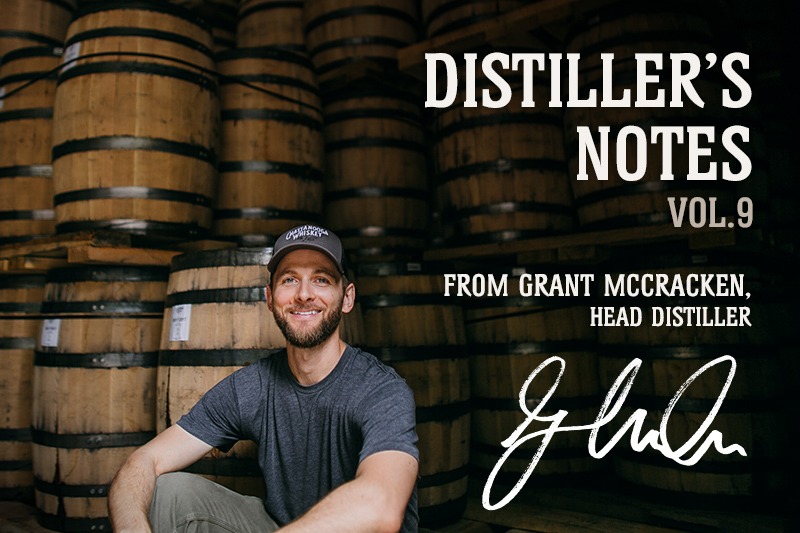
Distiller’s Notes Vol.9: Combinatory Play
I’ve been told that making whiskey is both an art and a science.
Flattering – but as much as I love music, I can barely hold an instrument right. And as interesting as something like physics can be, I’ve always been terrible at it. So saying someone can do both art and science – at the same time – seems like a stretch to me.
At some point, every artist and scientist grapples with feelings of inadequacy. Expressing yourself would seem like a great idea, until someone calls you a phony. Showing someone a theory you wrote down might seem cool, until you realize somebody else already proved the point.
Where did the all-time great artists and scientists get their inspiration? How’d they do it, again and again?
The Beatles? Einstein?
My first introduction to the Beatles was my dad’s copy of their Red & Blue, greatest hits, double albums. Before I ever listened to them, I saw the cassettes. The cover of the Red Album was a red-bordered version of the 1963 stairwell photo from their major label debut: Please Please Me. At that moment in their careers, the Fab Four looked eager to please; clean-cut and grinning ear-to-ear. 6 years later, they took that same picture again for the Blue Album. Here, the band looked a little more reflective and detached; long hair and beards now covering their half-smiles.
At the age of 7, I still hadn’t grasped the idea of people physically getting older, so seeing these two versions of the same photo next to one another was a bit of a time-trip. I actually remember wondering why two different groups of people had their photo taken in the same stairwell. “What was so special about this stairwell?” My dad then pointed out they were the same people – the same band.
7-year-old mind, blown.
One of my favorite songs on the Red Album was the 2nd song on the 2nd side of the cassette: “You’ve Got to Hide Your Love Away”. I didn’t realize it at the time, but John Lennon later admitted that this was him “in his Dylan period”, modeling his acoustic style and self-reflecting themes after his peer and creative hero. Meanwhile, Dylan (being Dylan) was already moving in the opposite direction. In fact, by the time the song was recorded, Dylan had abandoned his signature acoustic sound and – contrary to his fan’s expectations – performed a legendary, boo-filled electric set at the Newport Folk Festival.
To this day, I can’t help but hear Dylan in the song…but I still love it. My favorite part though, isn’t actually played by a Beatle; it’s the flute piece at the end of the song, played by a (then uncredited) composer named John Scott. Here, Scott plays 2 flutes (an alto and tenor), overdubbed from 2 separate tracks, to give the impression of a completely different instrument. And when the part’s over, the song simply ends.
One of my other favorite songs was the 2nd song on the 2nd side of the Blue Album: “While My Guitar Gently Weeps”. I didn’t realize it at the time, but George Harrison later said his song was based on the ideas of the I Ching – the book of Changes. Harrison interpreted this 9th century work as “everything is relative to everything else”, “whatever happens is all meant to be” and that “there’s no such thing as coincidence”. As a “study based on that theory”, he opened up the first book he saw, spotted the phrase “gently weeps”, and started to write the lyrics, “relative to that moment, at that time”.
I still get goosebumps when I listen to this song. But the part that makes it so special – again – doesn’t come from a Beatle. That iconic, lamenting (and then uncredited) guitar performance comes from the fingers of Harrison’s close friend, Eric Clapton. Clapton – who was initially hesitant to perform on Harrison’s song without the other Beatle’s approval – would end up having his solo overdubbed into the final cut, transforming it into the masterpiece that we know today. Ironically, when Harrison briefly quit the band in 1969, Clapton would be considered as his potential replacement. Then, as fate would have it, ended up replacing Harrison elsewhere: falling in love with his wife, writing “Layla” for her (and about her), and eventually marrying her himself.
Never being a student of music, I have no idea how these two songs actually “work”, on a musical level. Regardless, it doesn’t take a musician to realize how perfectly they both express the comings and goings of the most universal human force we know: Love.
In only 10 years together, the Beatles amassed a collection of art – from a collection of influences – amounting to more than most great bands do, in double the time. As much as their art evolved over that period, they always came back to one idea: Love. In fact – outside of generic pronouns and prepositions – their most frequently used word was “Love”. So it’s appropriate that in their final proper song of their final proper album, they leave us with the greatest closing line in the history of rock & roll:
“And in the end
The love you take
Is equal to the love you make”
Paul McCartney claimed this line was inspired by the greatest writer of all time: Shakespeare, saying he “followed The Bard and wrote a couplet”. As much as I love that explanation alone, the science fan in me hears something else: Einstein’s E=MC².
My first introduction to the greatest scientist of all time was through that same classic equation, though it meant nothing to me at the time. Sure, everything is energy, but why the hell is the speed of light squared?? And why is that same light shifting, red to blue??
I, like most, could only digest Einstein’s work through his, and other scientist’s thought experiments (i.e. fun stories to express complex, scientific theories). The first one I remember hearing was the “Twin Paradox”. Here, a paradox of time is illustrated through a twin’s story: one who stays on earth, and the other who travels through space, on a high-speed rocket ship. When the astronaut brother returns from his journey, he realizes he’s aged less than his now, gray-haired brother. At the time, I remember thinking this was just a silly story. Science fiction. Then, I realized that someone performed an actual experiment to prove the theory right.
14 year old mind, blown.
Thought experiments aside, I still don’t understand E=MC². Every time I dig into one of the 3 letters, I end up cross-eyed, frustrated, and leave with more questions than answers. If there’s one thing I do know though – it’s that the equation (E=MC²) and the person (Einstein), are now practically synonymous. And why not? Einstein’s 1905 paper – where the equation was famously derived – is still considered a watershed moment in modern physics. It was also special because, at that time, Einstein was largely an unknown in the physics world, pursuing his passion in his spare time as a patent clerk. Watershed or not, Einstein’s early work is still criticized for a number of reasons including a lack of citations, or even circular referencing himself. To this day, a “Relativity Priority Dispute” carries on, in the geeky subterranean world of physics, with seemingly no other purpose than give credit where credit is due.
Citations or no citations, Einstein did acknowledge his work was not created in a vacuum, at one point saying he was “standing on the shoulders” of another giant: James Clerck Maxwell. Maxwell, who many regard as the greatest scientist since Newton and before Einstein, brought electricity and magnetism together into one unified concept: electromagnetism. One of Maxwell’s students – John Poynting – then stood on the shoulders of Maxwell and Henrik Lorentz to develop a theoremthat would describe that the electromagnetic field, like mass, could be neither created nor destroyed. From there, Henry Poincaré stood on the shoulders of 2 more giants (Poynting and Lorentz) to more loosely prove M=E/C² as a paradox; which should look very familiar, even to a terrible physics student. Then, along came Einstein.
In 1686, Isaac Newton proved that mass can neither be created nor destroyed. 2 centuries later, a little known patent clerk began his 10-year obsession with a part-time physics hobby, eventually penning one of the most important equations of our time; a scientific formula so universal, beautiful and simple, it could even fit into a love song.
So maybe art and science can coexist. Better yet, maybe they’ve been together all along. Like magnetism & gravity, space & time – maybe these are two sides of the same coin? If so, could they be combined into some kind of unified theory of love and mass energy? Not surprisingly, someone’s already thought of that too. And for a minute, some people believed it was Einstein himself.
In April of 2015 an “Einstein” letter appeared on the internet with no citations or references. This letter – supposedly written by Einstein to his daughter – expressed love as a “universal force” and a hidden component within his E=MC² equation. “Love is light”, “Love is gravity”, “Love is power”.
While probably notThe Einstein, the person who wrote it seems to have realized the physicist’s penchant for cultivating ideas from different parts of his brain. Music for instance, was Einstein’s favorite way to take a break from a theory. As his wife once explained, “He goes to his study, comes back, strikes a few chords on the piano, jots something down, returns to his study.” Einstein even had a term for this activity: “Combinatory Play”.
As Einstein said (really),
“[T]he desire to arrive finally at logically connected concepts is the emotional basis of this rather vague [combinatory] play.” “But taken from a psychological viewpoint, this combinatory play seems to be the essential feature in productive thought — before there is any connection with logical construction in words or other kinds of signs which can be communicated to others.”
So we all know that good science requires proof of how you reached a conclusion. What Einstein realized, is that this process starts abstractly; as your mind grasps for connections, relative to the confluence of your every influence, and up to that very moment in space and time. If that’s the case, the fact that we’re all standing on each other’s shoulders seems somewhat beside the point…rather than on top of it.
So there you go. Maybe making whiskey really is both an art, and a science. But so is art, and so is science.
Now, can someone please tell me how to fit this “L” into E=MC²? I would try to do it myself, but I’m terrible at physics.

